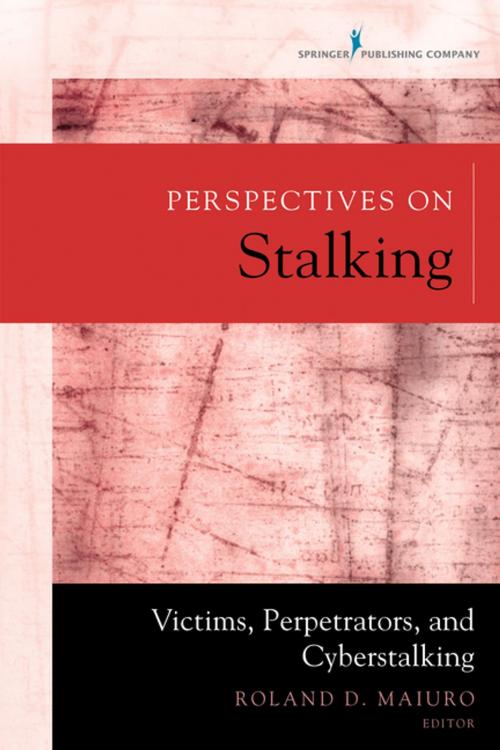Perspectives on Stalking
Victims, Perpetrators, and Cyberstalking
Nonfiction, Social & Cultural Studies, Social Science, Crimes & Criminals, Criminology| Author: | ISBN: | 9780826194695 | |
| Publisher: | Springer Publishing Company | Publication: | November 13, 2015 |
| Imprint: | Springer Publishing Company | Language: | English |
| Author: | |
| ISBN: | 9780826194695 |
| Publisher: | Springer Publishing Company |
| Publication: | November 13, 2015 |
| Imprint: | Springer Publishing Company |
| Language: | English |
Each year an estimated 3.4 million men and women become victims of stalking. While a man in a black coat following a girl in a dark alley is the media’s stereotypical portrayal of stalking, there is actually a wide range of behavior that can be defined as such. Stalking—characterized by harassment, repeated calling, sending inappropriate letters or gifts, unsuitable use of social media, confrontation, and other unwanted behaviors—is a worldwide problem that is on the rise, especially the incidence and prevalence of cyberstalking. This book presents a collection of prominent articles published in the peer-reviewed journal Violence and Victims, written by experts on stalking from a variety of social science disciplines. Authors present research related to stalking victims and perpetrators, cyberstalking, how to identify stalking, and stalking in a variety of settings with a focus on college campuses.
College students, many of whom are relatively new to intimate relationships, are especially prone to becoming stalked or perpetrating stalking. Several articles in this collection address stalking within the college population, including an empirical study of stalking victimization in men and women and a discussion of coping strategies at a Finnish university. Authors examine varying perceptions and attitudes toward stalking on campus, and discuss how to draw the line between courtship behavior and stalking. Personality attributes of stalkers include, according to one study, less social competence and a greater tendency to display borderline behaviors. Studies also address the relationship between stalking and gender, the stalking experiences of battered women, and the growing incidence of cyberstalking. This book will provide a solid research foundation toward understanding and controlling stalking behaviors, which can potentially lead to more serious abuse.
Key Features:
- Disseminates the most acclaimed research articles on stalking from the peer-reviewed journal Victims and Violence
- Authored by well-known stalking experts from varied social science disciplines
- Explores stalking in numerous settings including college campuses
- Presents research on perpetrators and victims of stalking
- Examines cyberstalking
Each year an estimated 3.4 million men and women become victims of stalking. While a man in a black coat following a girl in a dark alley is the media’s stereotypical portrayal of stalking, there is actually a wide range of behavior that can be defined as such. Stalking—characterized by harassment, repeated calling, sending inappropriate letters or gifts, unsuitable use of social media, confrontation, and other unwanted behaviors—is a worldwide problem that is on the rise, especially the incidence and prevalence of cyberstalking. This book presents a collection of prominent articles published in the peer-reviewed journal Violence and Victims, written by experts on stalking from a variety of social science disciplines. Authors present research related to stalking victims and perpetrators, cyberstalking, how to identify stalking, and stalking in a variety of settings with a focus on college campuses.
College students, many of whom are relatively new to intimate relationships, are especially prone to becoming stalked or perpetrating stalking. Several articles in this collection address stalking within the college population, including an empirical study of stalking victimization in men and women and a discussion of coping strategies at a Finnish university. Authors examine varying perceptions and attitudes toward stalking on campus, and discuss how to draw the line between courtship behavior and stalking. Personality attributes of stalkers include, according to one study, less social competence and a greater tendency to display borderline behaviors. Studies also address the relationship between stalking and gender, the stalking experiences of battered women, and the growing incidence of cyberstalking. This book will provide a solid research foundation toward understanding and controlling stalking behaviors, which can potentially lead to more serious abuse.
Key Features:
- Disseminates the most acclaimed research articles on stalking from the peer-reviewed journal Victims and Violence
- Authored by well-known stalking experts from varied social science disciplines
- Explores stalking in numerous settings including college campuses
- Presents research on perpetrators and victims of stalking
- Examines cyberstalking















